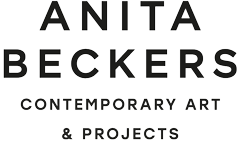ONE MOMENT IN TIME – PART III
Opening on January 23, 2019, 7 – 9 pm
Duration of exhibition:
January 23 – March 9, 2019
The exhibition „ONE MOMENT IN TIME – PART III“ is the last part in a series of exhibitions in honour oft the 20th anniversary of Galerie Anita Beckers. The show features works by Böhler & Orendt, Christiane Feser, Thomas Huber, Sebastian Kuhn and Ann Mandelbaum.
While the two previous anniversary exhibitions centered around the themes „identity“ and „immanence“, the current exhibition’s underlying motif is „the third dimension“. The term does not merely mean the classic notion of overcoming the two-dimensional or the expansion into depth. In this exhibition the term refers to the location itself and touches the question of the double nature of pictorial surfaces, which can refer to either the physical carriers or immaterial imagery.
The installation “The Carrion Cheer, a Faunistic Tragedy” by the artist duo Böhler & Orendt shows portraits of extinct animal species on a thin veil of mist in a darkened room. Returned from the afterlife this animals have a message for mankind. They make sounds and utter words, which form a collective choir – “the cadavers’ jubilant song”. The animated projections, which are designed to simulate the ghostly existence of those animals, are part of an installation with nine accessible tents. The full installation was shown at the Halsey Institute of Contemporary Art and the Kunsthalle Göppingen in 2018. As the installation was modified to fit the gallery space, the silhouette images originally found in the tents are replaced by woodcut images in an edition of 9 pieces. The animals display an ironic attitude regarding their extinction.
The viewer follows a totally different discourse in the examination of Christiane Feser’sphoto objects. Proceeding from the question of real-world references in photographic imagery the artist constructs complex surfaces from geometric forms, such as circles, rectangles, triangles and she experiments with light and shadow. In a procedure involving several processing steps, the artist transforms the photographic image of a paper medium into abstract photographic works. The result is a three-dimensional photographic object that displays various levels of reality.
With the work „Das Kreuz der Ehe / the cross of marriage“ by Thomas Huber, the view of the beholder is brought back to the interior – into the imaginary pictorial depth. Not only the title „the cross of marriage“ raises questions, also the perspective appears to be a border between the inexpressible and invisible. A portfolio was released with the same theme as this painting. Quote Thomas Huber: „The image holds the lost location. The myth regarding the godly origin of beauty lingers in the image. Images seem to come from far away now.“ This suggests that perspective in Thomas Huber’s work is not merely a method to approach reality, but is rather a tool to explore image space and is an opening to imaginary pictorial depths.
Two sensations lie close together when examining works by Sebastian Kuhn– recognition and alienation. In his sculptural compositions Kuhn uses objects and materials of our daily lives and gives them a new shape. Despite the seemingly bizarre combination of elements, the objects appear harmonious and possess an immanent aesthetic. Sebastian Kuhn’s sculptures not only expand into the room materially and claim the space around them, but they harbor interspaces, where light and shadow interplay on the surfaces and walls. The works display a lightness and delicacy, irrespective of the material density. Regardless of the dimensions the sculptures demand to be viewed from different perspectives. A work may seem to convey calm from one side, but might create the impression of enormous dynamic from the other.
In Ann Mandelbaum’sphotography extremities and body openings are portrayed in an obsessive close-up view. As a beholder one is not sure whether to get into it or stay away – or the way the artist puts it: „.. whether to reject or accept it“. The body parts seem magically charged or distorted in these surrealistic photographs. She captures the human body with her delicate camerawork and introduces current topics of the present day, such as the body-cult and obsession with beauty in contemporary body practices. Self-love and self-destruction are presented as a theme via needles, which pierce the skin. The beholder alternates between feeling attraction or repulsion.
